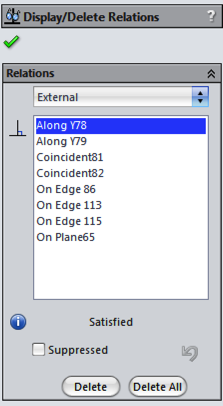Welcome to the Onshape forum! Ask questions and join in the discussions about everything Onshape.
First time visiting? Here are some places to start:- Looking for a certain topic? Check out the categories filter or use Search (upper right).
- Need support? Ask a question to our Community Support category.
- Please submit support tickets for bugs but you can request improvements in the Product Feedback category.
- Be respectful, on topic and if you see a problem, Flag it.
If you would like to contact our Community Manager personally, feel free to send a private message or an email.
How can I tell if an entity has any dependents?
 laird_broadfield
Member Posts: 42 ✭✭
laird_broadfield
Member Posts: 42 ✭✭
More specifically, I just rethought my layout on a part, and moved several sketches that had previously been on Plane 3 (offset) to use Top as their sketch plane. Much more sensible, once I had thought it through -- but now I have Plane 3 still in my workspace.
I'd like to delete it -- but other than deleting it and looking for weird changes or red rows, how can I tell if anything is based on or attached to Plane 3?
Thanks.
I'd like to delete it -- but other than deleting it and looking for weird changes or red rows, how can I tell if anything is based on or attached to Plane 3?
Thanks.
0
Best Answer
-
 billy2
Member, OS Professional, Mentor, Developers, User Group Leader Posts: 2,115 PRO
After thinking about this, I think Laird is right and we need to highlight dependencies. My suggestion is RMB on a feature and click on "highlight dependencies". You can suppress a feature and watch the errors, but this isn't a good design pattern.
billy2
Member, OS Professional, Mentor, Developers, User Group Leader Posts: 2,115 PRO
After thinking about this, I think Laird is right and we need to highlight dependencies. My suggestion is RMB on a feature and click on "highlight dependencies". You can suppress a feature and watch the errors, but this isn't a good design pattern.
I do what andrew has mentioned hoping the undo brings it back. Another way is to suppress the parent and the children will go with it. Just remember that if you un-suppress a parent, the children don't un-suppress with the parent. For this, you have use the drop down menu and use un-suppress with dependencies. Why do you have to use a drop down menu? They never asked me. So in short, if you suppress and then un-suppress watch out. Andrew's solution is probably a better solution if you trust the undo stack in SW.
I do use this cryptic dialog on occasion (I don't want this in OS, to confusing):
Just make sure there are no children before you delete the parent. If there are children, then you'll have to re-route the references to something else.
In OS, you can delete the parent and then go fix the children. I think this works best, if they keep this working. Pro/e deleted the children and SW copied this horrible behavior. I've promoted myself to the steward of this functionality and will scream if OS ever deletes a child.
Here's the dialog I miss the most:
This works on sketch dependencies. Above shows all relations (dependencies or references) outside the sketch. Also, and the most useful, is to toggle to "Dangling" and delete them all. Then make the blue sketch entities black again. It's really fast. I wish OS had this one.
5
Answers
Other packages which equate quantity (of features) with quality (of UX) quickly bloat to the point where many users are drowning in unused or poorly understood functionality. Even the fanciest "parent child" reporting has limitations, and there are situations (mainly to do with incidentally inferred constraints to entities further the tree) where "delete with the intention of undo" is the gold standard diagnostic - so perhaps there's not too much wrong with using it all the time, and getting familiar with it.
Nevertheless, "parent child" reporting can be very helpful when getting to grips with how to build a robust model, so I cannot pretend that nothing is lost by omitting it.
I do what andrew has mentioned hoping the undo brings it back. Another way is to suppress the parent and the children will go with it. Just remember that if you un-suppress a parent, the children don't un-suppress with the parent. For this, you have use the drop down menu and use un-suppress with dependencies. Why do you have to use a drop down menu? They never asked me. So in short, if you suppress and then un-suppress watch out. Andrew's solution is probably a better solution if you trust the undo stack in SW.
I do use this cryptic dialog on occasion (I don't want this in OS, to confusing):
Just make sure there are no children before you delete the parent. If there are children, then you'll have to re-route the references to something else.
In OS, you can delete the parent and then go fix the children. I think this works best, if they keep this working. Pro/e deleted the children and SW copied this horrible behavior. I've promoted myself to the steward of this functionality and will scream if OS ever deletes a child.
Here's the dialog I miss the most:
This works on sketch dependencies. Above shows all relations (dependencies or references) outside the sketch. Also, and the most useful, is to toggle to "Dangling" and delete them all. Then make the blue sketch entities black again. It's really fast. I wish OS had this one.